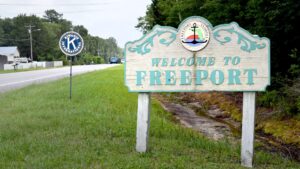
Freeport Florida began about 1830 when settlers were attracted to the natural harbor of LaGrange Bayou located near the eastern end of Choctawhatchee Bay and the mouth of the Choctawhatchee River.
ORIGIN OF THE NAME “FREEPORT”
Freeport was first known as Genoa and later Four Mile Landing. During the Civil War, Four Mile Landing began to be referred to as Freeport, literally because there was no charge to dock at the port area at the junction of Four Mile Creek and LaFayette Creek. Another locally circulated story is that at some point in that time period, an unclaimed shipment of wine was discovered in the port area and everyone in the area was encouraged to come have a little “free port”!
FIRST SETTLERS
Freeport remains home for many the founding families who first settled in this area. In the 1850 census, most of the heads of house were listed as farmer/boatmen. Many of the residents farmed their land and fished in the downtime or worked the commercial fishing boats/cargo vessels. The farmers traded their farm produce and livestock for other items they could not grow or make themselves. A goodly number of folk migrated to the area with the establishment of the lumber mills. The various landings were named for the families that settled along LaGrange Bayou, Four Mile Creek, Black Creek and the Choctawhatchee River.
INDUSTRY, PAST AND PRESENT
For many years, Freeport, with its steamboat and schooner connections to Pensacola, and up the Choctawhatchee River to Geneva, Alabama was the commercial and political hub of Walton County. The first mail delivered in the county came by water from Pensacola to Freeport and an overland stagecoach route from Tallahassee connected with steamboat service near Freeport. Most of the goods ordered from Pensacola were freighted from Freeport by commercially operated wagon trains which followed the route leading northeast from Freeport through the Euchee Valley to the town of Cerro Gordo on the Choctawhatchee River above Westville. Following Reconstruction (post-Civil War), the lumbering and naval stores industries became important. Mills were built along waterways as they had to depend on water transportation. In 1918, the Valparaiso Development Company purchased land at Freeport for the North and South Farms, planted sugar cane and shipped to Chicago.
Today, the Gulfstream Ship Building and Murphy USA dominate the original port area at the juncture of Four Mile Creek and LaFayette Creek at the head of LaGrange Bayou. A number of residents work at Eglin Air Force Base, as military personnel, contractors or civil service, but the lions share work south of the Bay in South Walton County is either in county employment, construction, or in one of the service industries associated with the tourist trade of that area (real estate, hotels, restaurants, retail, etc.)
Freeport is literally the crossroads between North and South Walton County. It is advantageously situated and within driving proximity to Tallahassee, Pensacola, Montgomery, Ft. Walton Beach, and Panama City. It is within an hour of the Northwest Florida Regional Airport, the NWFL Beaches International Regional Airport, the Destin Municipal Airport and the DeFuniak Springs Municipal Airport. It is a half-hour drive from the beaches and golf courses of South Walton. Freeport is a proud cooperative neighbor of Eglin Air Force Base which borders the city limits. Freeport is a progressive small city on the verge of great things to come!
Find out more about Freeport at their site: https://www.freeportflorida.gov/
This content is currently unavailable. Please check back later or contact the site's support team for more information.